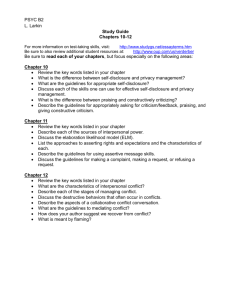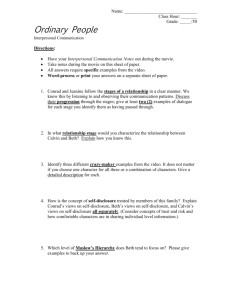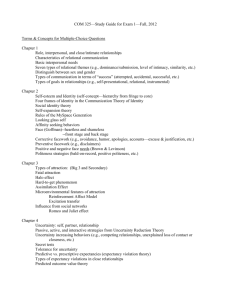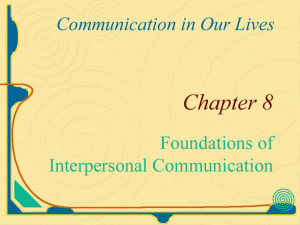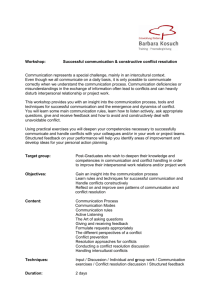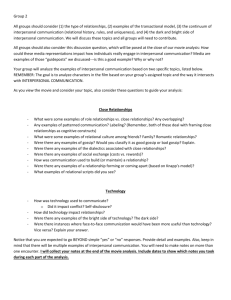Dark Side of Conflict - Gordon State College
advertisement
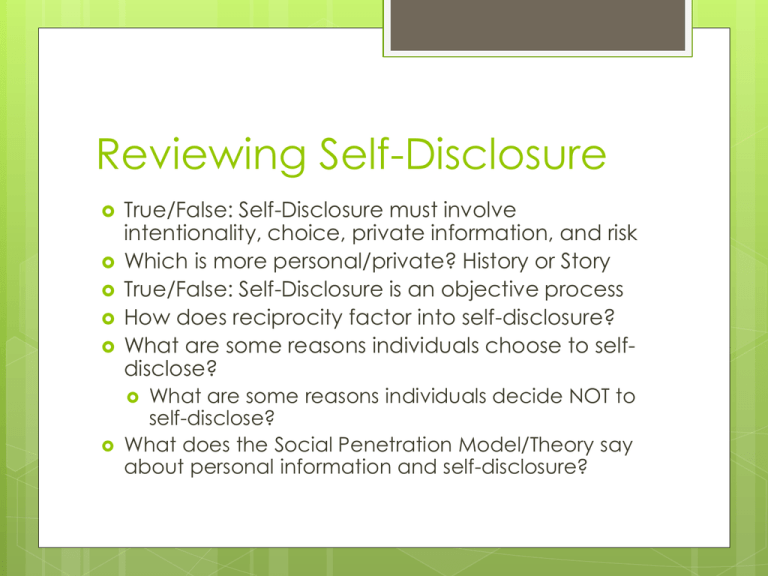
Reviewing Self-Disclosure True/False: Self-Disclosure must involve intentionality, choice, private information, and risk Which is more personal/private? History or Story True/False: Self-Disclosure is an objective process How does reciprocity factor into self-disclosure? What are some reasons individuals choose to selfdisclose? What are some reasons individuals decide NOT to self-disclose? What does the Social Penetration Model/Theory say about personal information and self-disclosure? Communicating Conflict Chapter 9 Recap/Lecture True or False? Conflict is avoidable Conflict can be productive Interpersonal Conflict “The interaction of interdependent people who perceive incompatible goals and interference from each other in achieving those goals” (p. 180) Elements of Interpersonal Conflict Interaction Interdependence Some relationship; need for each other Perceptions Created/sustained through communication ….of incompatible goals Also consider selective perceptions (in interactions) Conflict as Goal Oriented Incompatible goals Dark Side vs. Bright Side Dark Side of Conflict Bullying and Aggression Bright Side of Conflict Violence Managing conflict part of being a competent communicator Productive conflict management promotes physical and mental health Expressing feelings; learning those of others Relationship maintenance Increasing confidence Increasing depth Improves decision making skills Types of Conflict Image Conflicts Content (Substantive) Conflicts Issues about a relationship Serial Conflicts Addresses a question of right or wrong Relational Conflicts Public vs. Private Revolves around an issue Value Conflicts Disagreement about self definition/image Focuses on time frame; not subject (unlike other 4 types) Recur over time; no resolution Serial Conflicts Meta-Conflicts Overlapping? Myths about Conflict All conflict is a result of miscommunication Good communication resolves ALL conflict Talking about conflict is always the best strategy Additional: All conflict is negative Conflict is avoidable Role of Gender, Sex, and Culture Gender and Sex Relational life vs. Public life Collaborative vs. Competitive Culture How we behave in conflict What we have conflict about Communication Patterns Symmetrical Escalation Symmetrical Withdrawal Pursuit-Withdrawal vs. Withdrawal-Pursuit Symmetrical Negotiation Which of the patterns are positive? Negative? Explaining/Understanding Conflict The Four-Part Model Interdependence of Four Parts; happen simultaneously You and Me: Participants Context: Emotional background Subject: Topic of the argument Ignoring any part; unhealthy Placating (no “me”) Pouncing (no “you”) Computing (no “context”) Distracting (no “subject”) The Explanatory Process Model Conflict occurs in episodes Distal Context Background Proximal Context Conflict Interaction Proximal Outcomes Distal Outcomes Power and Conflict How do the two relate? Power = ‘ability to control behavior of others’ Use of Power Direct application of power (e.g. spanking) Direct and virtual use of power (e.g. threatening to spank) Indirect application of power (e.g. “I’d like to see that room clean asap”) Hidden Power (e.g. Turning down date; mom won’t approve) Power is relational Most consider responses to power Sex differences? Empowerment Relational messages (e.g. “I’m your mother”) Conflict Management Staying calm (lightening up) Stay in the present Acknowledge other’s comments Provide nonverbal and verbal feedback Reframing Presume/express goodwill; don’t expect the worst Ask questions Listen Consider active listening Practice cultural sensitivity Application Exercise Create a skit about interpersonal conflict based on the type of conflict you are assigned Your skit should walk us through the conflict based on what was discussed in the chapter Use an example of a communication pattern and/or the use of power (as discussed in the chapter) After each skit, groups will have to walk us through how the skit served as a real life example of interpersonal conflict Using the Four Part Model or the Explanatory Model (whichever you are assigned) Cannot pull an example from the book; be creative!!! Film Analysis Project – Group Meetings Proposals Due – Oct. 23rd

